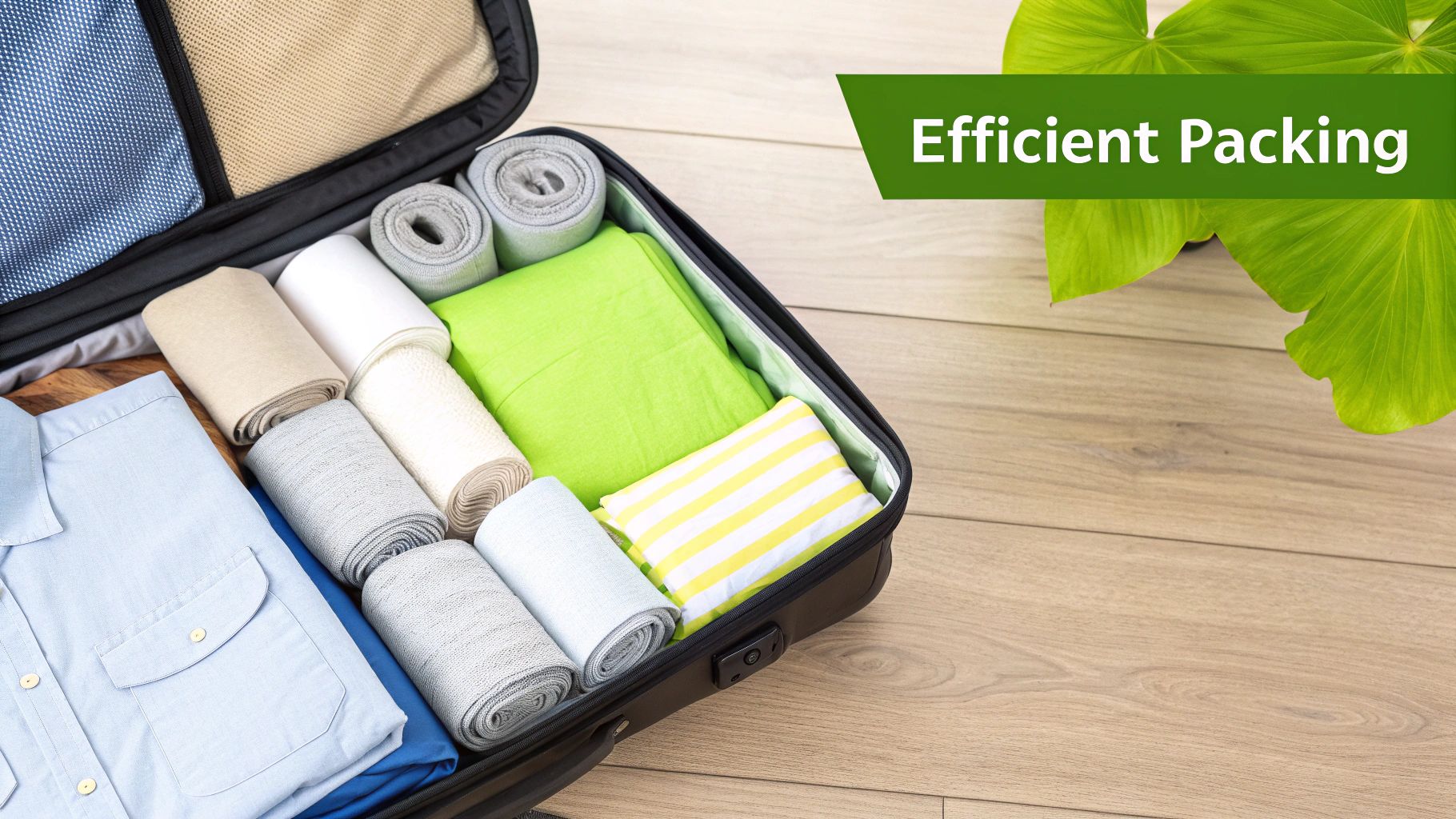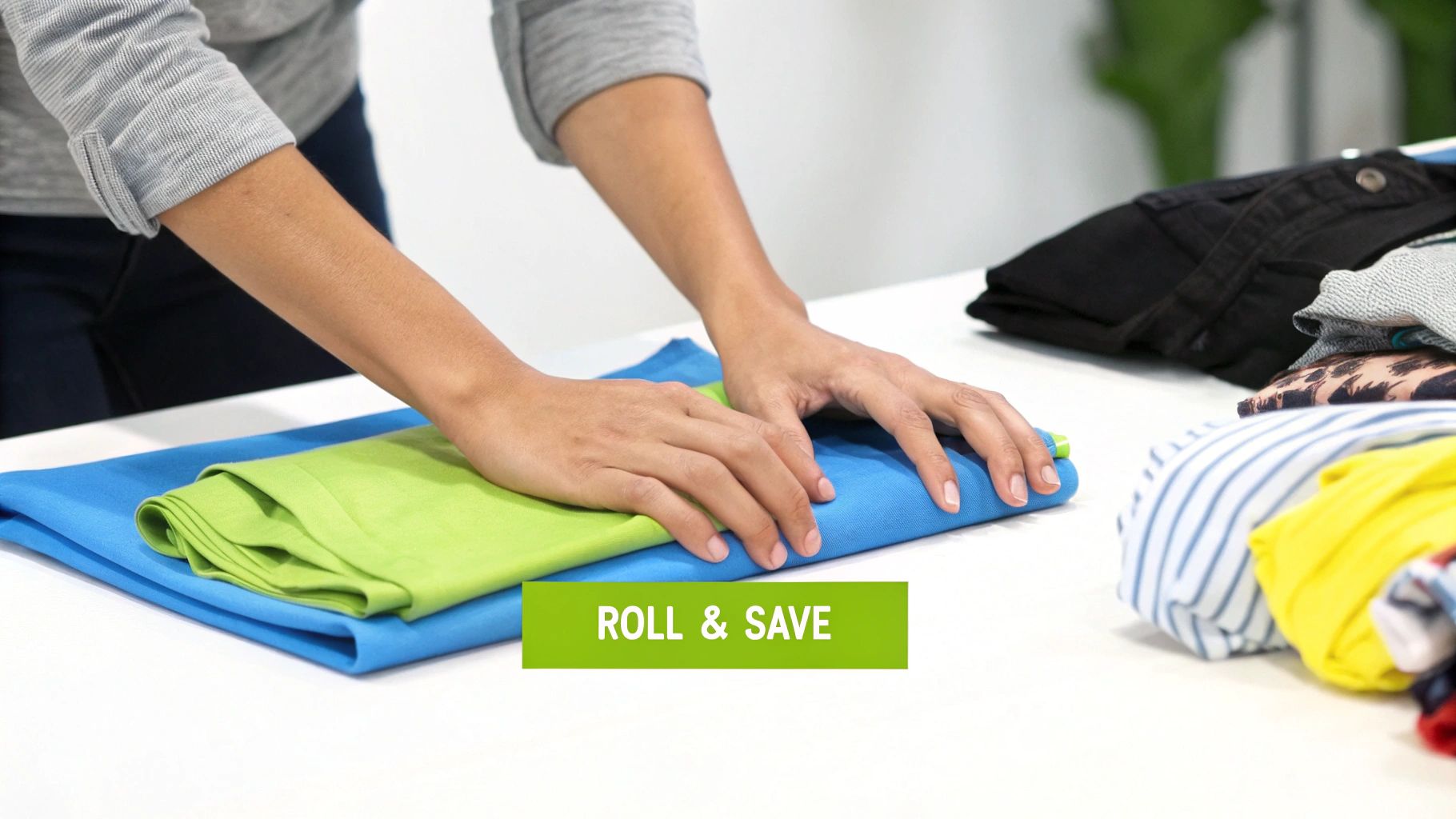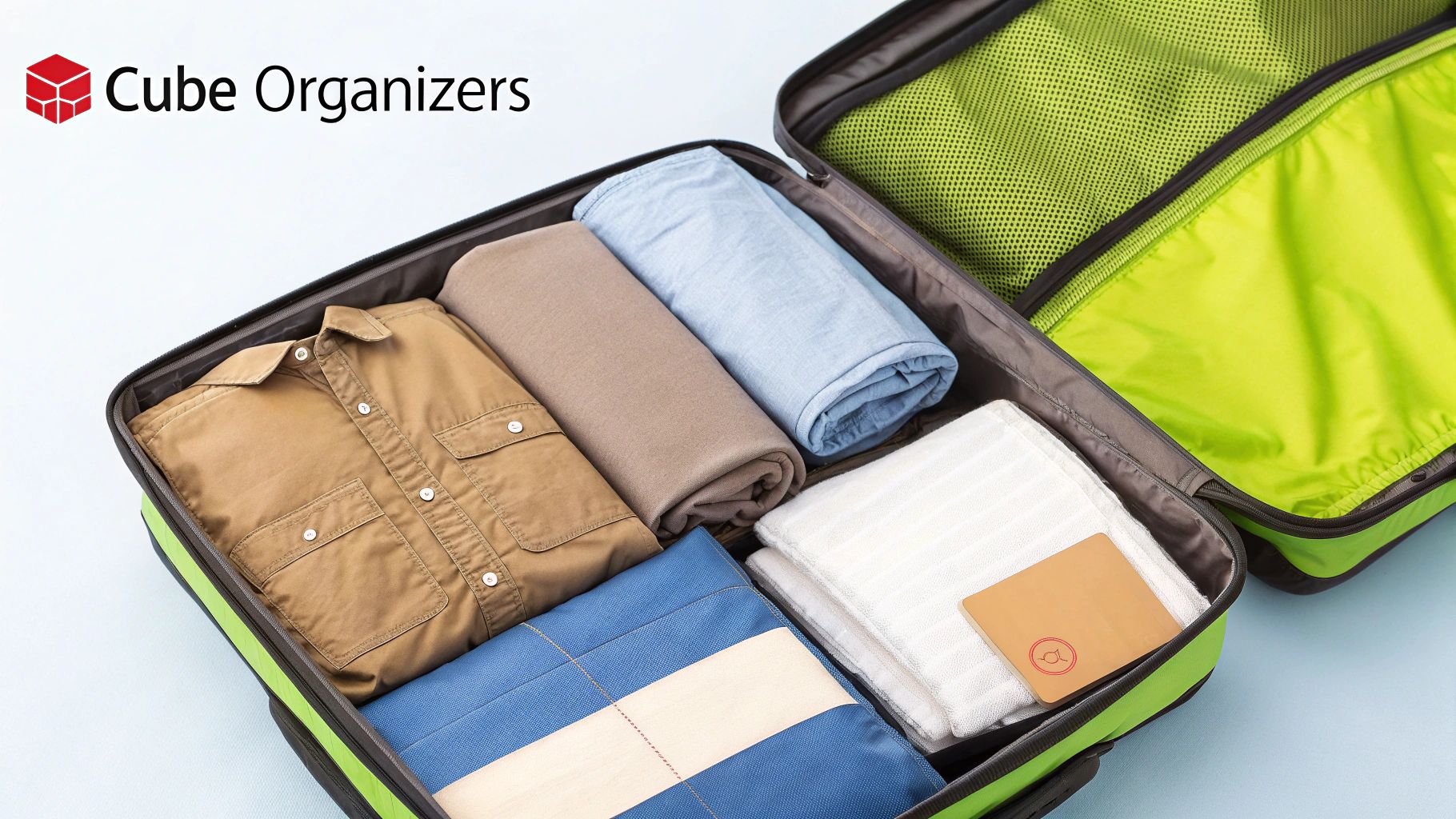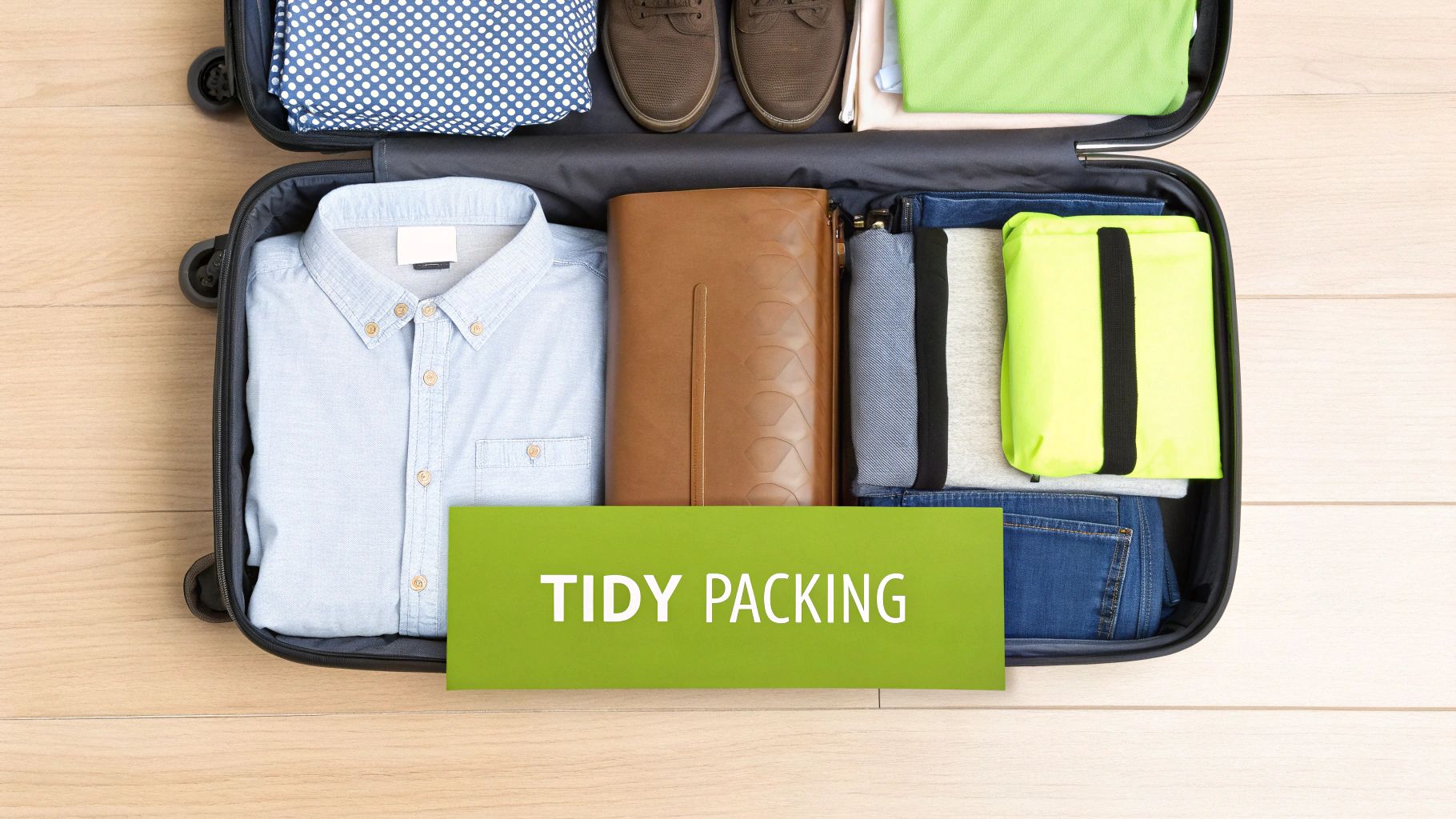The Art of Tight Packing: Why It Transforms Travel

Overpacked luggage can quickly make travel stressful. Mastering the art of tight packing isn't just about avoiding extra baggage fees; it's about a smoother, more enjoyable travel experience. From easily navigating airports to seamlessly moving between locations, packing light has a positive impact on every aspect of your trip.
This efficient approach allows you to embrace spontaneity and enjoy the things that truly matter: exploring new places, relaxing, and creating lasting memories.
The Benefits of Packing Light
Packing light offers numerous advantages, from physical comfort to peace of mind. Imagine bypassing baggage claim and heading straight to your destination with just a single carry-on. This is the freedom that smart packing provides.
-
Increased Mobility: Navigating crowded streets, using public transportation, and handling stairs is much easier with less luggage.
-
Reduced Stress: Eliminate the worry of lost luggage or the struggle of heavy suitcases.
-
Cost Savings: Avoid checked baggage fees and potentially opt for smaller, more affordable rental cars.
-
Spontaneous Exploration: With a lightweight and adaptable packing strategy, you're ready for unexpected adventures and detours.
This agility and freedom allow you to fully immerse yourself in your travels. Packing strategically also means bringing only what you need, promoting mindful consumption and reducing the environmental impact of your trip.
Tailoring Your Packing Strategy
Different trips require different packing strategies. A business trip calls for a different approach than backpacking or a family vacation. Consider the climate of your destination, planned activities, and the length of your stay.
-
Business Trips: Pack wrinkle-resistant clothing and use garment bags to protect suits and dresses.
-
Adventure Travel: Choose durable, quick-drying fabrics and use compression sacks to maximize space.
-
Family Vacations: Use packing cubes to organize each family member's belongings and simplify unpacking.
Analyzing your travel needs helps you develop a packing system that maximizes space and minimizes stress. This personalized approach is the key to unlocking the full potential of tight packing and transforming your travel experience. For further insights into efficient packing strategies, check out resources like How Luggage Weight Limits Influence Your Packing Strategy for Efficient Travel. Studies show that 60% of travelers experience difficulties with bag management, highlighting the importance of thoughtful packing. By using techniques like rolling clothes or compression bags, you can significantly reduce luggage volume and make your travel experience much smoother.
Rolling Revolution: Maximize Space While Minimizing Wrinkles

Rolling your clothes can be a real game-changer for packing. Not only does this method save valuable space in your luggage, but it also helps keep wrinkles at bay, ensuring your clothes look fresh throughout your trip. Let's explore the art of rolling, from the basics to more advanced techniques.
Mastering the Basic Roll
The basic roll is the cornerstone of efficient packing. It's surprisingly effective for items like t-shirts, jeans, and casual dresses.
- Lay the garment flat: Smooth it out to remove any existing wrinkles.
- Fold sleeves inward: For shirts, fold the sleeves across the back of the garment.
- Roll from the bottom up: Starting at the hem, roll tightly towards the neckline, creating a compact cylinder.
This simple method creates a neat little bundle that easily fits into your luggage. Plus, you can see all your rolled items at a glance, which makes unpacking and repacking much easier.
Advanced Rolling Techniques
Want to take your rolling game to the next level? Try these advanced methods for even better results.
- The Military Roll: This technique involves tucking in the bottom of the garment before rolling. This creates a tighter, more secure roll, perfect for bulky items like sweaters and jackets.
- The Ranger Roll: Similar to the military roll, the ranger roll starts by folding the garment in half lengthwise. Then, you roll it up, creating a compact, rectangular shape. This works especially well for pants and long-sleeved shirts.
These advanced techniques offer extra compression and wrinkle resistance, helping you pack even more into your bag.
Garment-Specific Rolling Strategies
While the basic roll is versatile, some garments benefit from a slightly different approach. For delicate blouses, rolling them inside out protects embellishments and delicate fabrics. For bulky sweaters, folding them in half lengthwise before rolling creates a more manageable shape.
Let's look at how rolling compares to traditional folding. The table below summarizes the key differences.
To help you visualize the differences, here's a comparison table:
Rolling vs. Folding Comparison: A detailed comparison of rolling clothes versus traditional folding across multiple factors including space efficiency, wrinkle prevention, and accessibility.
| Technique | Space Efficiency | Wrinkle Prevention | Accessibility | Best For |
|---|---|---|---|---|
| Rolling | Excellent, up to 30% more space | Good | Very Good, items easily visible | Casual clothes, travel |
| Folding | Fair | Fair, creases can form | Fair, items can be stacked | Formal wear, storage at home |
This table highlights the benefits of rolling, particularly for travel. Rolling allows you to maximize space while keeping your clothes relatively wrinkle-free. While folding might be better for preserving the shape of formal wear, rolling wins for travel convenience.
Optimizing Luggage Space with Rolled Clothes
Once you’ve rolled your clothes, think strategically about how you arrange them in your luggage. Placing heavier rolled items at the bottom, near the wheels, creates a stable base and prevents shifting during travel. Lighter items can then be placed on top, filling in any gaps.
Rolling, combined with other packing strategies like packing cubes or compression sacks, can significantly improve your packing efficiency. In fact, rolling can often create up to 30% more space compared to traditional folding. By strategically packing your rolled clothes, you can create a well-organized suitcase that maximizes space and makes unpacking and repacking a breeze.
Compression Technology: Your Space-Saving Secret Weapon

Beyond simply rolling your clothes, compression technology offers a powerful way to pack tightly. By removing air from your clothing, you can significantly reduce the amount of space they take up in your luggage. Whether you choose vacuum-sealed bags or innovative roll-top compression sacks, there's a compression solution for every travel style.
Understanding Compression Systems
Different compression systems offer unique advantages and disadvantages. Vacuum bags, for instance, provide the highest compression level. Using a vacuum cleaner or a hand pump, you can shrink bulky items like sweaters and jackets down dramatically. However, this method isn't suitable for all fabrics, and you'll need access to a vacuum to repack when your trip ends.
Roll-top compression bags, on the other hand, provide a convenient, equipment-free alternative. A one-way valve lets air escape as you roll the bag, offering moderate compression without needing a vacuum. These bags are ideal for longer trips or backpacking adventures. Packing clothes tightly is essential for maximizing luggage space. For more packing tips, check out WowFare's blog on Effective Packing Techniques. Did you know that 66% of travelers actively look for ways to optimize their luggage space?
Choosing the Right Compression Solution
The best compression system for you depends on several factors, like the length of your trip and the types of clothes you're packing. For shorter trips with lighter items, packing cubes with compression features might be all you need. These cubes offer a good balance of organization and compression, perfect for weekend getaways or business trips where wrinkle-free clothes are a must.
If you're planning a longer trip with bulkier items like winter clothing or technical gear, consider a more powerful compression method. Vacuum bags excel at reducing volume, allowing you to pack more. Roll-top compression bags are also a versatile option, suitable for a wide range of clothing and easy to use without extra equipment.
Maximizing Compression Effectiveness
To maximize the effectiveness of your compression bags, follow these tips: First, make sure your clothes are completely dry before packing to avoid mildew and maximize space savings. Smooth out your clothes inside the bag to eliminate air pockets before sealing or rolling. Finally, place heavier items at the bottom of the bag for a stable base.
Troubleshooting Compression Issues
Occasionally, you might run into problems with your compression bags. If a bag loses its seal, check for punctures or tears. For vacuum bags, ensure the valve is closed tightly and the vacuum hose is securely attached. Overfilling can strain the seams and reduce effectiveness. For bulky items like winter coats, consider layering techniques and using compression bags for other clothes to maximize space in your suitcase. By understanding the nuances of compression technology, you can pack more efficiently and enjoy a more organized travel experience.
Bundle Wrapping: The Executive Approach to Wrinkle-Free Packing

Bundle wrapping is a packing method loved by travelers who want to keep their clothes looking sharp while also saving space. It involves wrapping garments around a central core, creating a compact and organized bundle. This technique is particularly useful for delicate items prone to wrinkling.
Building Your Core and Layering for Success
The secret to successful bundle wrapping lies in choosing the right core and layering your clothes strategically. The core can be a small, soft pouch filled with socks and underwear, or even a neatly folded sweater. Think of it as the foundation of your bundle, providing structure and cushioning for your clothes.
Around this core, you’ll wrap your clothing in layers, starting with the most wrinkle-resistant items and progressing to the most delicate. This helps distribute pressure evenly and minimizes creases.
- Core: Small pouch of socks/underwear or a folded sweater
- Inner Layer: Wrinkle-resistant items (jeans, knitwear)
- Middle Layer: Shirts and blouses
- Outer Layer: Delicate items (dresses, blazers)
This layered approach helps protect your clothes and keeps them looking their best.
Adapting Bundle Wrapping to Different Wardrobes
One of the best things about bundle wrapping is its adaptability. For business trips, you can create a core from dress pants and wrap shirts, blouses, and a blazer around it, keeping your professional attire wrinkle-free. For casual travel, a core of shorts or a t-shirt works perfectly. This flexibility makes bundle wrapping a great packing solution for any type of trip.
Protecting Collars and Preventing Creases
A few extra steps can further enhance the wrinkle-fighting power of bundle wrapping. Try placing tissue paper or plastic wrap around collars to prevent them from getting crushed. Folding dress pants along the creases before wrapping keeps them crisp. Turning tailored pieces inside out offers extra protection and helps maintain their shape. These small details can make a big difference in the condition of your clothes after a long journey.
Real-World Applications of Bundle Wrapping
Experienced travelers rely on bundle wrapping for a variety of trips. It’s ideal for keeping formal wear pristine for destination weddings. For international business travel, it helps professionals maintain a polished image. Even when packing for multiple climates, bundle wrapping keeps everything organized and compact. Travel expert Samantha Brown highlights the benefits of packing cubes, a similar concept, in her article on packing a week's worth of clothes in a carry-on, calling them "serious game changers." Bundle wrapping offers similar organization and space maximization while also adding the benefit of wrinkle prevention. Mastering this technique can truly transform your packing experience.
Strategic Layering: Engineering Your Perfect Packing System
Let's be honest, stuffing clothes haphazardly into a suitcase is never a good strategy. Instead, think of packing as a precise engineering project where every item has its place. Strategic layering, a technique favored by logistics professionals and frequent fliers, optimizes space and minimizes wasted volume, truly changing how you use your luggage.
Weight Distribution and Stability
Just like a well-designed building, a well-packed suitcase needs a stable foundation. Distributing weight evenly prevents your belongings from shifting during transit and keeps everything secure. Start by placing heavier items, like shoes and toiletries, at the bottom of your bag. If you're using a rolling suitcase, positioning these heavier items near the wheels is ideal. This creates a lower center of gravity, improving the bag's stability.
Consider, for instance, the Titantrek vacuum compression backpack. Even with its built-in compression system, strategic layering further boosts efficiency. Placing heavier items against the back panel enhances comfort and balance, a particularly valuable feature for hikers and city explorers.
Identifying and Utilizing 'Dead Zones'
Every bag, regardless of size or style, has its quirks. Those awkwardly shaped spaces, often referred to as "dead zones," frequently go underutilized. Identifying these areas is critical for truly tight packing. These zones might be the gaps between rolled clothing in a suitcase or the spaces around the handle mechanism.
Understanding your luggage type is key. A backpack might have a slim pocket perfect for rolled t-shirts, while a hard-shell suitcase is best suited for flat-packed dress shirts against its rigid interior. Adapting your packing technique to each bag’s unique shape maximizes every available inch.
Creating an Intuitive Access System
Efficient packing shouldn't sacrifice accessibility. The goal is an intuitive system that prioritizes frequently-needed items while maintaining a tight pack. Packing cubes offer a great solution. They categorize and compress clothing, allowing you to access specific items without unpacking everything, and simplifying repacking. Travel expert Samantha Brown recommends packing cubes for fitting a week's worth of clothes in a carry-on. This method is a game-changer, especially for travelers who frequently change locations. Similar sentiments are echoed on The Wonder of Wandering blog, which emphasizes minimizing luggage through thoughtful preparation.
Layering Systems for Different Travel Scenarios
Packing strategies should align with your travel plans. A weekend trip requires a different approach than a month-long backpacking adventure. For shorter trips, focus on versatile clothing that can be mixed and matched, maximizing outfits with minimal items.
For longer journeys, a modular approach is beneficial. Divide your luggage into sections designated for different activities or climates. This provides easy access to specific items without disturbing your entire packing system. For instance, dedicate one packing cube for warm-weather clothing, another for hiking gear, and a third for formal wear. This level of organization streamlines your travel experience and eliminates the frustration of rummaging through a tightly packed bag.
To better illustrate the space-saving potential of different packing methods, let's take a look at the following table. It provides a quantitative comparison based on luggage type and clothing categories.
Space-Saving Metrics by Packing Method
| Packing Method | Space Saved (%) | Best Luggage Type | Ideal for Clothing Types | Difficulty Level |
|---|---|---|---|---|
| Rolling | 20-30 | Soft-sided suitcases, backpacks | T-shirts, pants, casual wear | Easy |
| Folding | 10-15 | Hard-sided suitcases, garment bags | Dress shirts, formal wear | Easy |
| Bundling | 15-25 | Backpacks, duffel bags | Mixed clothing types | Medium |
| Compression Cubes | 30-40 | Any luggage type | All clothing types | Easy |
| Vacuum Bags | 50-60 | Any luggage type | Bulky items (sweaters, jackets) | Medium |
As the table shows, vacuum bags offer the most significant space savings, especially for bulky items. Compression cubes provide a good balance between space optimization and ease of access. Rolling remains a simple yet effective method for most casual clothing.
By understanding these various packing methods and tailoring your approach to your specific needs, you can maximize space and minimize travel stress.
Packing Cubes: Organization That Maximizes Every Inch
Packing cubes are a real difference-maker for travelers looking to pack efficiently. These simple organizers transform messy suitcases into streamlined systems, maximizing space and minimizing wrinkles. Instead of adding bulk, packing cubes actually increase luggage capacity by compressing clothes and eliminating wasted space.
Choosing the Right Packing Cubes
The best cube configuration depends on your trip and packing style. For a weekend trip, a set of small cubes might be enough for shirts, pants, and underwear. But, for longer international trips, a combination of small, medium, and large cubes allows for better organization. Larger cubes can hold bulky sweaters, while smaller ones work well for socks, underwear, or electronics.
Maximizing Cube Efficiency
Packing cubes aren't just containers, they're tools for strategic packing. Combine rolling and folding within a single cube to make the most of the space. Roll t-shirts and jeans, then place them next to folded dress shirts in a larger cube. This creates a compact and organized system. Travel expert Samantha Brown often recommends combining packing cubes and rolling for maximum efficiency, calling them “serious game changers.”
Creating a Logical Cube System
The real benefit of packing cubes is creating a system that makes it easy to find things on your trip. Give each cube a specific purpose: one for tops, one for bottoms, and another for underwear and socks. This helps you find what you need without unpacking everything. It also makes repacking simpler.
Specialized Cube Strategies
Consider specialized strategies for different clothes and climates. Use a dedicated cube for business clothes to keep dress shirts and suits wrinkle-free. For athletic wear, choose a breathable mesh cube. When packing for varying temperatures, assign different cubes to each climate. This makes adjusting to changing weather much easier.
Tips From Travel Professionals
Frequent travelers have developed clever packing cube techniques. Some use different colored cubes for each family member for easy identification. Others use compression packing cubes specifically for bulky items like sweaters and jackets.
By following these tips and adding packing cubes to your routine, you can improve your packing and enhance your entire travel experience.
Ready to pack smarter? The Titantrek vacuum compression backpack takes packing efficiency to a whole new level. Pack more, stress less, and travel farther with Titantrek. Learn more and get yours today!

Top Packing Compression Bags for 2025 Travel
European Airlines Carry-On Size Limits 2025